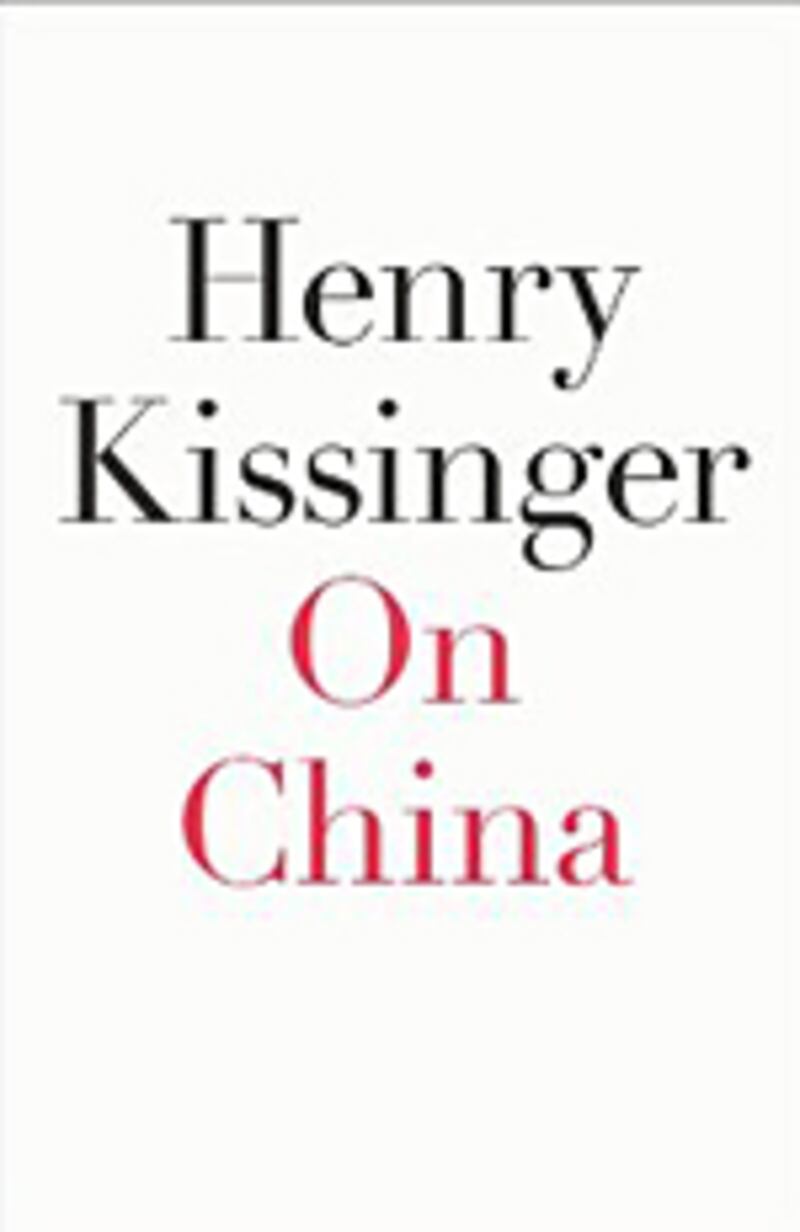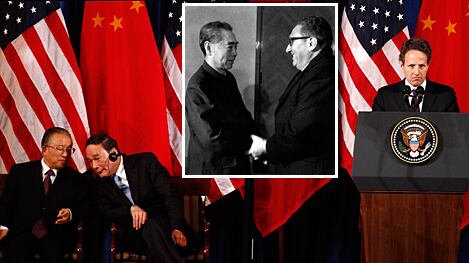Secretary of State Hillary Clinton thinks the Chinese government is “scared” of the Arab Spring. “They’re worried,” she told Jeffrey Goldberg in the latest Atlantic, “and they are trying to stop history, which is a fool’s errand. They cannot do it.”
These are words—intemperate, undiplomatic, and very likely counterproductive—that you cannot imagine being uttered by her predecessor Henry Kissinger.

It is now 40 years since Kissinger went on his secret mission to China, to pave the way for President Richard Nixon’s historic visit the following year. Since then he has visited the country more than 50 times. And if there is one thing he has learned, it is this: the real fool’s errand is to lean on the Chinese.
Much has changed in the world since Kissinger’s first trip to China. (In 1971, who would have dared to predict that America’s public enemy No. 1 would be a Saudi-born Islamic fundamentalist skulking in a walled compound in Pakistan?) But at least two things in American foreign policy remain consistent: the relationship with mainland China, revived by Kissinger after more than 20 years in the deep freeze, and Kissinger himself, consulted formally or informally by every president from John F. Kennedy to Barack Obama. On China, Kissinger’s new book, is a reminder of why our leaders still want to pick his brains. Eighty-eight years old this month, he remains without equal as a strategic thinker.
The opening to China is a story Kissinger has told before: how he and Nixon had discerned that country could become a strategic counterweight to the Soviet Union; how he secretly flew to China after feigning illness in Pakistan; how he and Premier Zhou Enlai hammered out the diplomatic basis for Nixon’s official visit (the Shanghai Communiqué). The result was, as he puts it, “a quasi alliance,” which, though initially intended to contain the Soviet Union, ended up outliving the Cold War.

In this telling, however, Kissinger is able to take advantage of recent research that illuminates the Chinese side of the story. The American opening to China was also a Chinese opening to America, actuated above all by Mao Zedong’s fear of encirclement. “Think about this,” Mao told his doctor in 1969. “We have the Soviet Union to the north and the west, India to the south, and Japan to the east. If all our enemies were to unite, attacking us from the north, south, east, and west, what do you think we should do?” The medic had no idea. “Think again,” said Mao. “Beyond Japan is the United States. Didn’t our ancestors counsel negotiating with faraway countries while fighting with those that are near?” It was to explore the American option that Mao recalled four Army marshals from exile. Skirmishes were already underway between Soviet and Chinese forces on the Ussuri River. In October 1970 Mao ordered China’s top leadership to evacuate Beijing and put the People’s Liberation Army on “first-degree combat readiness.” The stakes for China were high indeed—higher than for the United States.
As Kissinger shows, it was far from unusual for Mao to refer to “our ancestors’ counsel.” Despite his lifelong commitment to Marxism-Leninism, Mao was also steeped in the classics of Chinese civilization, as were his close advisers. “We can consult the example of Zhuge Liang’s strategic guiding principle,” Marshal Ye Jian-ying suggested, “when the three states of Wei, Shu, and Wu confronted each other: ‘Ally with Wu in the east to oppose Wei in the north.’ ” The allusion, Kissinger explains, is to Romance of the Three Kingdoms, a 14th-century epic novel set in the so-called Three Kingdoms Period (c. 180–280).
Nor was this the only occasion when China’s communist leaders looked to the distant past for inspiration. Of equal importance to them, Kissinger argues, was The Art of War by Sun Tzu, which dates from the even earlier Spring and Autumn period (770–476 B.C.). “The victorious army/Is victorious first/And seeks battle later”: axioms like this one encouraged Chinese strategists to think of international relations like the board game Weiqi (known in the West as Go), a “game of surrounding pieces.”
Mao shared with China’s prerevolutionary leaders an assumption that China is not like other countries. With a population that amounts to a fifth of humanity, it is Zhongguo: the Middle Kingdom or, perhaps more accurately, the “Central Country.” At times it could even seem like tian xia: “all under heaven.” The best foreign policy for such an empire was to “let barbarians fight barbarians.” If that failed, then the strongest of the barbarians should be embraced and civilized (as happened to the Manchus).
“Domineering and overwhelming … ruthless and aloof, poet and warrior, prophet and scourge”—Mao’s true hero was not Lenin but the tyrannical, book-burning “first emperor,” Qin Shi Huang, who united China in 221 B.C. In a similar way, Kissinger shows, the current generation of Chinese leaders have drawn inspiration from the teachings of Kong Fu Zi (known in the West as Confucius). Their goal, he argues, is not world domination but da tong: “great harmony.”
This goes to the heart of the matter. In 1971, when Kissinger first went to China, the U.S. economy was roughly five times that of the People’s Republic. Forty years later, as a result of the industrial revolution unleashed by Mao’s successor Deng Xiao-ping, it is conceivable that China could overtake America within a decade. This is a feat the Soviet Union never came close to achieving. Moreover, China is now the biggest foreign holder of U.S. Treasury notes, which form an important part of its vast $3 trillion of international reserves. How China will use its newfound economic power may be the most important question of our time. Few Americans are better placed to answer that question than Kissinger, who has dealt with four generations of Chinese leaders.
The most profound insights of On China are psychological. They concern the fundamental cultural differences between a Chinese elite who can look back more than two millennia for inspiration and an American elite whose historical frame of reference is little more than two centuries old. This became most obvious in the wake of June 1989, when Americans recoiled from the use of military force to end the Tiananmen Square pro-democracy demonstrations. To Kissinger’s eyes, it was doubly naive to retaliate to this crackdown with sanctions: “Western concepts of human rights and individual liberties may not be directly translatable … to a civilization for millennia ordered around different concepts. Nor can the traditional Chinese fear of political chaos be dismissed as an anachronistic irrelevancy needing only ‘correction’ by Western enlightenment.”
As China’s first Anglophone leader, Jiang Zemin, explained to Kissinger in 1991: “We never submit to pressure … It is a philosophical principle.”
The United States and China went to war in Korea because of another cultural gap. It came as a surprise to the Americans when Mao ordered Chinese intervention because the military odds looked so unfavorable. But, argues Kissinger, his “motivating force was less to inflict a decisive military first blow than to change the psychological balance, not so much to defeat the enemy as to alter his calculus of risks.” Mao was a master of the ancient Empty City Stratagem, which seeks to conceal weakness with a show of confidence, even aggression. To Westerners, his insistence that he did not fear a nuclear attack seemed unhinged or, at best, callous (“We may lose more than 300 million people. So what? War is war. The years will pass, and we’ll get to work producing more babies than ever before”). But this was classical Chinese bravado, or “offensive deterrence.”
“Chinese negotiators,” observes Kissinger in a passage that should be inwardly digested not just by American diplomats but also by American businessmen before they land in Beijing, “use diplomacy to weave together political, military, and psychological elements into an overall strategic design.” American diplomacy, by contrast, “generally prefers …c to be ‘flexible’; it feels an obligation to break deadlocks with new proposals—unintentionally inviting new deadlocks to elicit new proposals.” We could learn a thing or two from the Chinese, Kissinger implies, particularly Sun Tzu’s concept of shi, meaning the “potential energy” of the overall strategic landscape. Our tendency is to have an agenda of 10 different points, each one to be dealt with separately. They have one big game plan. We are always in a hurry for closure, anxiously watching the minutes tick away. The Chinese value patience; as Mao explained to Kissinger, they measure time in millennia.
Such fundamental cultural differences may give rise to conflict with China in the future, Kissinger warns: “When the Chinese view of preemption encounters the Western concept of deterrence, a vicious circle can result: acts conceived as defensive in China may be treated as aggressive by the outside world; deterrent moves by the West may be interpreted in China as encirclement. The United States and China wrestled with this dilemma repeatedly during the Cold War; to some extent they have not yet found a way to transcend it.”
Could the United States and the People’s Republic come to blows again? The possibility cannot be excluded. As Kissinger reminds us, war was the result when Germany rose to challenge Britain economically and geopolitically 100 years ago. Moreover, the key factor that brought America and China together in the 1970s—the common Soviet enemy the Chinese called “the polar bear”—has vanished from the scene. Old, intractable differences persist over Taiwan and North Korea. What remains is “Chimerica,” a less-than-happy marriage of economic convenience in which one partner does all the saving and the other does all the spending.
In Kissinger’s own words, China’s rise could “make international relations bipolar again,” ushering in a new cold (or possibly even hot) war. Nationalist writers like Liu Mingfu, author of China Dream, urge China to switch from “peaceful development” to “military rise” and look forward to the “duel of the century” with the United States. There are those in Washington, too—apparently including, for the moment, the Obama administration—who would relish a more confrontational relationship.
Yet Kissinger remains hopeful that cooler heads will prevail in Beijing: thinkers like Zheng Bijian, who urges China to “transcend the traditional ways for great powers to emerge” and “not [to] follow the path of Germany leading up to World War I.” Rather than attempting to “organize Asia on the basis of containing China or creating a bloc of democratic states for an ideological crusade,” the United States would do better, Kissinger suggests, to work with China to build a new “Pacific Community.”
Four decades ago, Richard Nixon grasped sooner than most the huge potential of China. “Well,” he mused, “you can just stop and think of what could happen if anybody with a decent system of government got control of that mainland. Good God … There’d be no power in the world that could even—I mean, you put 800 million Chinese to work under a decent system … and they will be the leaders of the world.” That prophecy is being fulfilled in our time. The fact that until now China’s rise has been a boon to the United States rather than a bane owes much to the work of Henry Kissinginer. With this book he has given his successors an indispensable guide to continuing the Sino-American “coevolution” he began.
Correction: The original version of this article incorrectly stated that The Romance of the Three Kingdoms was set in the Warring States Period. It was in fact set in the Three Kingdoms Period (c. 180-280).
Plus: Check out Book Beast, for more news on hot titles and authors and excerpts from the latest books.
Niall Ferguson is a professor of history at Harvard University and a professor of business administration at Harvard Business School. He is also a senior research fellow at Jesus College, Oxford University, and a senior fellow at the Hoover Institution, Stanford University. His latest book, The Ascent of Money: A Financial History of the World , was published in November.





